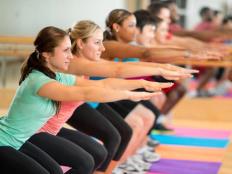If you've spent all fall, winter and spring cooped up indoors, check out this list of common summer workout mistakes before jumping into your outdoor training.
1. Not Drinking Until You're Thirsty
1 of 11
Don't wait until you're thirsty to drink. Exercising in the summer sun means your body is using water to regulate your temperature. When you're low on fluids, fatigue sets in and you can't perform optimally. Always have a bottle of water with you for long workouts, and drink a glass or two before heading out.
It's also important to realize that not all liquids are created equally. Drinking that morning cup of Joe might seem like a good way to wake up, but it's not the best way to stay hydrated. In fact, coffee or any high-caffeine drink can act as a diuretic and cause more fluid loss than normal when consumed before a workout.
Find:
Fitness Classes Near You2. Skimping on Sunscreen
2 of 11
Even if it looks partly cloudy outdoors, that summer sun can hit you hard. When heading outdoors, use a sweat-proof SPF of 30 or higher and reapply every two hours for moderate exercise, or every 45 to 60 minutes during intense fitness.
Each time we burn, we increase our risk for skin cancer, and one especially bad sunburn can double your risk for malignant melanoma, the most dangerous form of skin cancer.
Find:
Fitness Classes Near You3. Not Checking the Clock
3 of 11
When it comes to training outdoors, remember that summer temperatures climb earlier in the day. Avoid exercising outdoors between the hours of 10 a.m. and 3 p.m. when it's generally the hottest. Work out bright and early in the morning or wait until the cooler evening hours before hitting the trail.
When given the option, choose shaded trails to stay out of the direct path of the sun.
Find:
Fitness Classes Near You4. Cranking Up the Altitude
4 of 11
Looking to hit the mountains? Before you go from treadmill to trail, remember that the outdoors are different. Sure, pollution and air quality come into play, but so does altitude. High altitude—thought to be about 5,000 feet or above—poses an added challenge compared to sea level exercise, because less oxygen is available.
Consider starting your outdoor journey on level ground and ease into challenging climbs.
Find:
Fitness Classes Near You5. Wearing Improper Clothing
5 of 11
Skin hugging outfits or stink-saving polyester blends aren't the best choice when exercising outdoors. Instead, beat the heat by wearing loose fitting, light-colored clothing. Aim for cotton blends so that you can get the benefit of limited post-workout stench while limiting the moisture absorbed by 100 percent cotton garment (and the accompanying "heavy" feeling).
Choose breathable synthetics that wick away sweat and keep you cool.
Find:
Fitness Classes Near You6. Bringing Fido with You for Every Workout
6 of 11
Nothing is better than logging a few miles with your furry best friend once the weather warms up, but summer temperatures and high humidity can be especially harmful for dogs. Thanks to all that fur and a naturally high body temperature, dogs feel the heat even more than you do. Plus, their main defense mechanism—panting—becomes less effective the more humid it is.
On especially hot days, consider leaving your favorite pal at home where he or she can rest comfortably until it cools down.
Find:
Fitness Classes Near You7. Skimping on Electrolytes
7 of 11
High temperatures mean more sweat, which can translate into major electrolyte-loss. If you're going to be logging some serious workouts outside, you need to recover with more than just water.
Focus on drinks that replace sodium, but do your body a favor and skip all the artificial ingredients and added sugars of popular sports drinks. Opt for something healthier like coconut water, all-natural cherry juice or chocolate milk—just make sure to check the label for added sugars.
Find:
Fitness Classes Near You8. Holding Yourself to the Same PRs
8 of 11
If you can run an 8-minute mile on your best day or complete a brutal circuit workout in 20 minutes flat, expect a drop in performance once temperatures rise, especially with high-intensity cardio efforts.
Holding yourself to the same standards that you meet in an air-conditioned gym or a perfect 60-degree day will only lead to disappointment. Instead, set different PRs for warmer weather and keep them realistic.
Find:
Fitness Classes Near You9. Not Checking the Weather Forecast
9 of 11
Chances are, if you exercised outdoors during the winter, you constantly checked the weather beforehand. Will it be snowing? Will it be below freezing? At what time does the sun set? What's the wind chill factor? You should be showing the same diligence with your summer workout.
Keep your eye on humidity levels, heat advisories and the "feels like" temperature (usually much higher than the actual temperature), so you can make important choices on when and how to exercise that day.
Find:
Fitness Classes Near You10. Overdoing It
10 of 11
Sure, you want to look good for the beach, but going all out once summer hits could be a mistake. Pushing too hard in the beginning—think two-a-day workouts and hours of cardio—is the easiest way to burnout and bring your fitness journey to a halt.
Don't make the mistake of ignoring exhaustion. Exercising in summer heat can make it easy to brush off that sluggish feeling, but being tired isn't something you should ignore. If you feel dizzy, faint or nauseated, listen to your body and stop.
Find:
Fitness Classes Near YouGet ACTIVE on the Go


Couch to 5K®
The best way to get new runners off the couch and across the finish line of their first 5K.
Available for iOS | Android






Discuss This Article